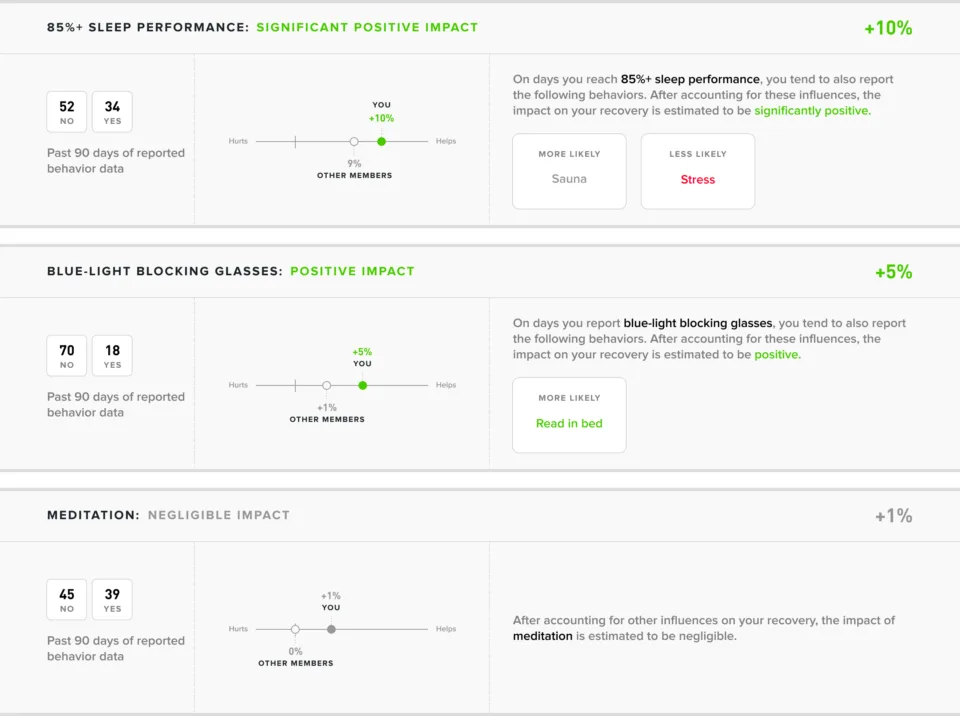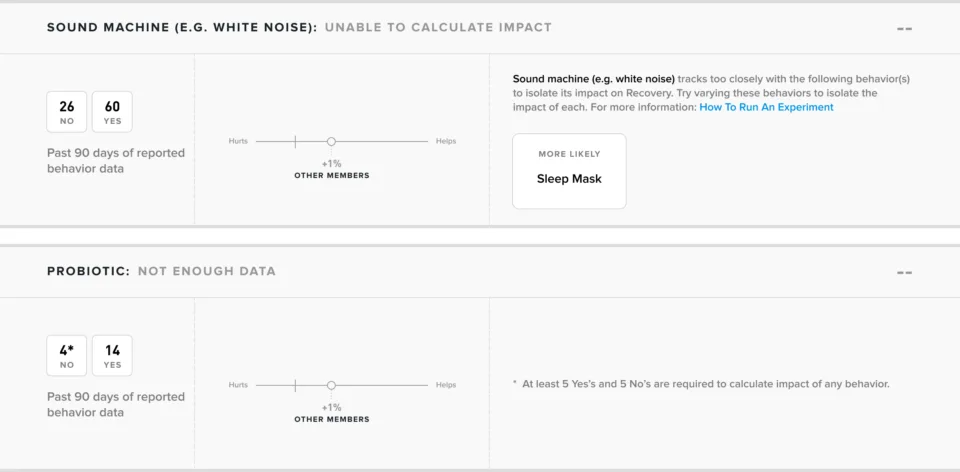Topics
- Article
- App & Features
- Recovery
Monthly Performance Assessment Now Features Enhanced Recovery Analysis

We’ve upgraded the Monthly Performance Assessment to give you a much better understanding of how specific choices and behaviors you log in the WHOOP Journal impact your daily recovery.
The WHOOP Journal allows members to track various choices and behaviors, and the Monthly Performance Assessment provides analysis into how these behaviors impact your recovery.
These behaviors span across a wide range of categories including nutrition choices, lifestyle, bedtime routines, active recovery modalities (things like meditation and stretching), and more.
Previously, in the MPA we reported the difference in average recovery when you engaged in or didn’t engage in a certain behavior. However, at times this could be misleading.
Exploring Confounding Factors
For example, let's say you wanted to understand whether (and how much) stretching after hard workouts helps you recover. Hypothetically, maybe you tracked stretching in the Journal for a month and learned that on days you didn’t stretch your next-day recovery average was 67%, whereas on days you did stretch it was much lower, maybe only an average of 49%. Should you stop stretching?
Well, no. If you only stretch after intense workouts, the lower recovery average is most likely from the heavy strain you took on those days, not from stretching. Taking your workouts into consideration, what is the true effect of stretching on your recovery?
Another example we’d get questions about from time to time, what if your average recovery on days after drinking alcohol is higher than when you weren’t drinking alcohol? We know alcohol is extremely detrimental to recovery, so what might be going on here?
Perhaps you drank alcohol mostly on the weekends, and those also tended to be less stressful days for you. Maybe you didn’t work out as much either and took on less strain than normal. There’s also a good chance you might have slept for significantly longer than usual. Therefore, on those days your recoveries were likely higher on average because the positive impact of all these other things (less stress, lower strain, more sleep) outweighed the negative effects of the alcohol you consumed.
In short, there were factors other than alcohol that contributed to the increase in average recovery--other behaviors confounding the effect of alcohol on your recovery.
Isolating the Effects of Single Behaviors on Recovery
What if we want to understand the isolated effect of just one behavior on recovery? This is what the new recovery analysis in the Monthly Performance Assessment now shows you.
To help members better understand the long-term, isolated effect of each behavior they record in the Journal, we are now using data accumulated up to a year.


The upgraded Journal analysis summarizes the distribution of daily recoveries and highlights the behaviors that are most positively and negatively associated with recovery. In the example above, the behaviors associated with the largest positive change in recovery are an 85%+ sleep performance and blue-light blocking glasses, and those associated with the largest negative change are consuming alcohol and using tobacco.

The percentage point shown for each behavior is now an estimate of the behavior’s isolated contribution to your recovery when also examining other factors.
Here, after taking into account your sleep, workouts, and all other behaviors that you are tracking (including sauna and stress), alcohol alone is associated with a 17-point decrease in your recovery.
Related to this metric, the report also shows:
- The average magnitude of alcohol’s estimated impact for everyone. In this example, alcohol is associated with a 9-point decrease in average recovery across all WHOOP members.
- Other behaviors that tend to coincide with days you engage in each behavior. Here, on days the member drinks alcohol they are much less likely to log stress and more likely to log sauna. So in this case, stress and sauna were some of the greatest confounding behaviors taken into account when parsing the isolated effect of alcohol.
Each behavior is also bucketed into one of the following categories regarding its impact on your recovery: Significant positive/negative impact, positive/negative impact, or negligible positive/negative impact.

Sometimes, WHOOP will not be able to provide an estimate of a behavior’s individual effect on recovery. There are two primary cases that lead to this (see below):
- The behavior coincided almost perfectly with another behavior or behaviors that the member was tracking. For example, if the member always or almost always used a sound machine on days he/she wore a sleep mask, then it is not possible to determine whether a change in recovery score is attributable to the sound machine or sleep mask.
- The member did not have at least 5 “Yes” and 5 “No” responses in the Journal for a behavior.

While our new analysis takes into account sleep, workouts, and other Journal behaviors to isolate the effect of each behavior you log, it is important to note that we can only adjust for confounding factors that are tracked on WHOOP. Therefore, there could very well be other behaviors or conditions still confounding the estimated impact of each behavior on recovery.
Recommended Recovery Behaviors
Additionally, the MPA now suggests other behaviors you might like to try to positively impact your recovery. These recommendations are made based on what you track and things that work for other members like you.

We analyze data from members that are most similar to you in the behaviors that they log, and then rank the most effective ones that you haven't tried in the past year.